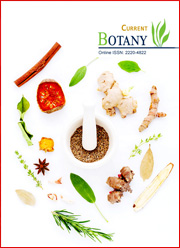Exploring the underexplored genus Chenopodium, a potentially neglected underutilized species from Manipur North Eastern Region of India
DOI:
https://doi.org/10.25081/cb.2025.v16.9580Keywords:
Flora, New addition, Indo Burma Biodiversity Hotspot, Plant TaxonomyAbstract
The Northeastern region (NER) of the India is home to a rich diversity of plant species. Many of them are underexplored and nurtured by indigenous communities for their potential value to humankind. The genus Chenopodium of family Amaranthaceae is one of the neglected and underutilized plant species known for its higher content of protein, minerals, vitamins and abiotic stress tolerance. However, taxonomically this genus is known to be a complex genus due to the lack of good morphological characters that can distinguish species. This genus has around 132 accepted species worldwide. In the present study, we have briefly described four Chenopodium species viz. Chenopodium murale, C. ficifolium, C. giganteum and C. album from Manipur, India. Of these, three species viz. C. murale, C. ficifolium, and C. giganteum are new records from Manipur, India.
Downloads
References
Abbas, M. N., Rana, S. A., Shahid, M., Rana, N., Mahmood-ul-Hassan, M., & Hussain, M. (2012). Chemical evaluation of weed seeds mixed with wheat grains at harvest. Journal of Animal & Plant Sciences, 22(2), 283-288.
Bhargava, A., Shukla, S., Srivastava, J., Singh, N., & Ohri, D. (2008). Chenopodium: a prospective plant for phytoextraction. Acta Physiologiae Plantarum, 30, 111-120. https://doi.org/10.1007/s11738-007-0097-3
Devi, T. S., Devi, M. H., Singh, S. S., Thokchom, R., & Singh, P. K. (2022). Studies on the income-generating wild edible wetland plants traditionally consumed by the people of Bishnupur district, Manipur. The Pharma Innovation, 11(11), 915-920.
Don, D., Hamilton, F., & Wallich, N. (1825). Prodromus florae Nepalensis: Sive enumeratio vegetabilium quae in itinere per Nepaliam proprie dictam et regiones conterminas, ann. 1802-1803. Detexit atque legit D. D. Franciscus Hamilton (olim Buchanan) accedunt plantae A. D. Wallich nuperius missae. J. Gale. https://doi.org/10.5962/bhl.title.86
Fuentes-Bazan, S., Uotila, P., & Borsch, T. (2012). A novel phylogeny-based generic classification for Chenopodium sensu lato, and a tribal rearrangement of Chenopodioideae (Chenopodiaceae). Willdenowia, 42(1), 5-24. https://doi.org/10.3372/wi.42.42101
Gohar, A. A., Maatooq, G. T., Niwa, M., & Takaya, Y. (2002). A new triterpene saponin from Chenopodium ficifolium. Zeitschrift für Naturforschung C, 57(7-8), 597-602. https://doi.org/10.1515/znc-2002-7-808
Hooker, J. D. (1875). The flora of British India. L. Reeve. https://doi.org/10.5962/bhl.title.678
Jaenicke, H., & Höschle-Zeledon, I. (2006). Strategic framework for underutilized plant species research and development. Colombo, Sri Lanka: ICUC; Rome: GFU; Rome: IPGRI.
Javaid, A., & Amin, M. (2009). Antifungal activity of methanol and n-hexane extracts of three Chenopodium species against Macrophomina phaseolina. Natural Product Research, 23(12), 1120-1127. https://doi.org/10.1080/14786410802617433
Kanjilal, U. N., Kanjilal, P. C., De, R. N., & Das, A. (1940). Flora of Assam - Nyctaginaceae to Cycadaceae (Vol. 4). Government of Assam: Assam, India.
Le Dang, Q., Lee, G. Y., Choi, Y. H., Choi, G. J., Jang, K. S., Park, M. S., Soh, H. S., Han, Y. H., Lim, C. H., & Kim, J.-C. (2010). Insecticidal activities of crude extracts and phospholipids from Chenopodium ficifolium against melon and cotton aphid, Aphis gossypii. Crop Protection, 29(10), 1124-1129. https://doi.org/10.1016/j.cropro.2010.06.009
Linnaeus, C. (1753). Species plantarum (Vol. 1). Holmiae: Impensis Laurentii Salvii.
Mroczek, A. (2015). Phytochemistry and bioactivity of triterpene saponins from Amaranthaceae family. Phytochemistry Reviews, 14, 577-605.
https://doi.org/10.1007/s11101-015-9394-4
Padulosi, S., Hoeschle-Zeledon, I., & Bordoni, P. (2008). Minor crops and underutilized species: lessons and prospects In N. Maxted, B. V. Ford-Lloyd, S. P. Kell, J. M. Iriondo, M. E. Dulloo & J. Turok (Eds.), Crop wild relatives, conservation and use. Wallingford, UK: CAB International.
Pal, A., Banerjee, B., Banerjee, T., Masih, M., & Pal, K. (2011). Hepatoprotective activity of Chenopodium album Linn. plant against paracetamol induced hepatic injury in rats. International Journal of Pharmacy and Pharmaceutical Sciences, 3, 55-57.
Paul, T. K. (2012). A synopsis of the family Chenopodiaceae in India. Pleione, 6(2), 273-297.
POWO. (2025). Plants of the World Online. Royal Botanic Gardens, Kew.
Prajapati, N. D., Purohit, S. S., Sharma, A. K., & Kumar, T. A. (2003). Hand book of medicinal plants: A complete source book. Rajasthan, India: Agrobios India.
Saleem, M., Ahmed, B., Qadir, M. I., Mahrukh, Rafiq, M., Ahmad, M., & Ahmad, B. (2014). Hepatoprotective effect of Chenopodium murale in mice. Bangladesh Journal of Pharmacology, 9(1), 124-128. https://doi.org/10.3329/bjp.v9i1.17785
Sarma, H., Sarma, A. M., & Sarma, C. M. (2008). Traditional knowledge of weeds: A study of herbal medicines and vegetables used by the Assamese people (India). Herba Polonica, 54(2), 80-88.
Singh, S. J., Batra, V. K., Singh, S. K., & Singh, T. J. (2012). Diversity of underutilized vegetable crop species in North-East India with special reference to Manipur: A review. NeBIO, 3(2), 87-95.
Smith, J. E. (1800). Flora Britannica (Vol. 1). Londini: Typis J. Davis; veneunt apud J. White. https://doi.org/10.5962/bhl.title.125864
Sukhorukov, A. P., Liu P. L., & Kushunina, M. (2019). Taxonomic revision of Chenopodiaceae in Himalaya and Tibet. PhytoKeys, 116, 1-141. https://doi.org/10.3897/phytokeys.116.27301
Zaman, U., Naz, R., Khattak, N. S., ur Rehman, K., Iqbal, A., Ahmad, S., & Shah, L. A. (2020). Investigating the thermodynamic and kinetics properties of acid phosphatase extracted and purified from seedlings of Chenopodium murale. International Journal of Biological Macromolecules, 165, 1475-1481. https://doi.org/10.1016/j.ijbiomac.2020.10.041
Zenith, N., Nimai, W., & Romharsha, H. (2016). An overview of plants used as anthelmintic in Manipur. International Journal of Sciences and Applied Research, 3(12), 1-5.
Published
How to Cite
Issue
Section
Copyright (c) 2025 Rajkumari Jashmi Devi, Biseshwori Thongam

This work is licensed under a Creative Commons Attribution-NonCommercial 3.0 Unported License.



 .
.